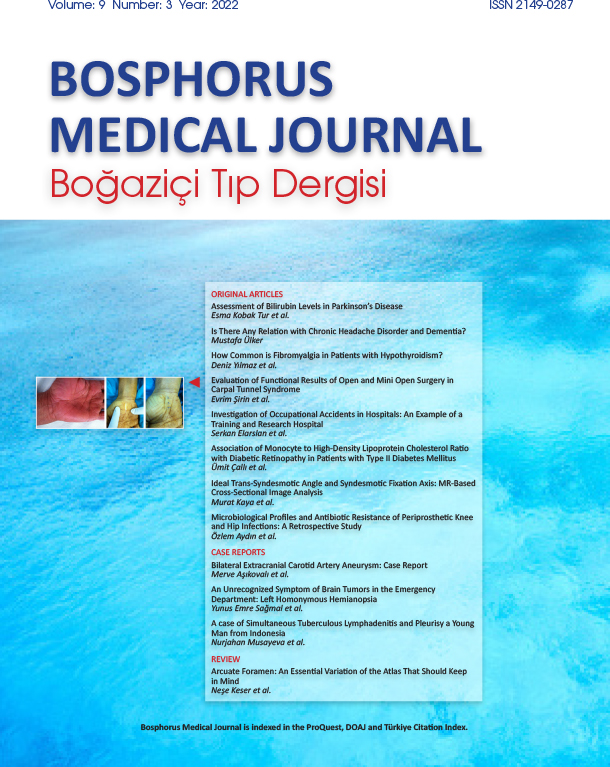Fistula Treatment By Steam Ablation Method In Rats
Mehmet Mahir Fersahoğlu1, Anıl Ergin1, Nuriye Esen Bulur1, Ayşe Tuba Fersahoğlu1, Hüseyin Çiyiltepe1, Birol Ağca1, Hasan Murat Arslan2, Adnan Somay3, Engin Sümer41Fatih Sultan Mehmet Research and Training Hospital, General Surgery Department, İstanbul2Fatih Sultan Mehmet Research and Training Hospital, Cardiovascular Surgery Department, İstanbul
3Fatih Sultan Mehmet Research and Training Hospital, Pathology Department, İstanbul
4Yeditepe University, Veterinary Department
INTRODUCTION: Anal fistula is a common condition in surgical practice. Despite its benign course, treatment is difficult, especially in complicated fistulas.Anal fistula surgery can cause recurrence or continence disturbances. Ideal treatment should provide low incontinence and recurrence rates. Conventional techniques have a variable success rate; together with the potential risks, the outcome depends on the anatomy of the patient and the fistula and the wishes of the patient. For anal fistulas, various new procedures must be applied in animals to minimize the potential risk to humans.
Steam Ablation (SA) is an application like Laser Ablation (LA), which is mainly used in the treatment of varicose veins in the lower extremities in humans. In this study, we aimed to evaluate the efficacy of SA treatment in an experimentally created anal fistula model in rats.
METHODS: Two fistula tracts were formed in the anus of 16 Wistar Albino rats. After waiting for 30 days, SA was applied to one of the tracts while the other was left untreated as control. The animals were euthanized 60 days after the start of the experiment and the samples were analyzed by the pathologist by removing the perianal regions. Regarding the results, a value of p<0.05 was considered statistically significant.
RESULTS: 18.8% of the study group had a complete recovery, 31.3% had a moderate improvement, 50% did not seem any recover, and none of the control group showed a full recovery, 37.5% had moderate recovery, 62.5% had no recovery, among them There is no statistically significant difference (p> 0.05).
DISCUSSION AND CONCLUSION: In this study, where we evaluated the effectiveness of SA in the treatment of fistulas created in rats, we compared the treatment group with the control group. Improvement in the SA group was greater than in the control group, but there was no statistically significant difference between the groups.
Keywords: Fistula-in-ano, Steam Ablation, Rats
Ratlarda Buhar Ablasyon Yöntemi İle Fistül Tedavisi
Mehmet Mahir Fersahoğlu1, Anıl Ergin1, Nuriye Esen Bulur1, Ayşe Tuba Fersahoğlu1, Hüseyin Çiyiltepe1, Birol Ağca1, Hasan Murat Arslan2, Adnan Somay3, Engin Sümer41Fatih Sultan Mehmet Eğitim ve Araştırma Hastanesi, Genel Cerrahi Kliniği, İstanbul2Fatih Sultan Mehmet Eğitim ve Araştırma Hastanesi, Kalp Damar Cerrahi Kliniği, İstanbul
3Fatih Sultan Mehmet Eğitim ve Araştırma Hastanesi, Patoloji Kliniği, İstanbul
4Yeditepe Üniversitesi, Veterinerlik Kliniği, İstanbul
GİRİŞ ve AMAÇ: Anal fistül, cerrahi uygulamada sık görülen bir durumdur. İyi huylu seyrine rağmen özellikle komplike fistüllerde tedavisi zordur. Anal fistül ameliyatı, nüks veya kontinans bozukluklarına neden olabilir. İdeal tedavi, düşük inkontinans ve nüks oranları sağlamalıdır. Geleneksel teknikler değişken bir başarı oranına sahiptir; Olası risklerle birlikte sonuç, hastanın anatomisine, fistüle ve hastanın isteklerine bağlıdır. Anal fistüller için, insanlara yönelik potansiyel riski en aza indirmek için hayvanlarda çeşitli yeni prosedürler uygulanmalıdır.
Buhar Ablasyonu (SA), esas olarak insanlarda alt ekstremitelerde varis tedavisinde kullanılan Lazer Ablasyon (LA) gibi bir uygulamadır. Bu çalışmada, sıçanlarda deneysel olarak oluşturulmuş bir anal fistül modelinde SA tedavisinin etkinliğini değerlendirmeyi amaçladık.
YÖNTEM ve GEREÇLER: 16 adet Wistar Albino sıçanın anüsünde 2 adet fistül traktı oluşturuldu. 30 gün beklendikten sonra traktların birine SA uygulanırken, diğer trakt kontrol olarak tedavisiz bırakıldı. Deneyin başlangıcından 60 gün sonra hayvanlara ötenazi uygulandı ve perianal bölgeleri çıkarılmak suretiyle örnekler patolog tarafından analiz edildi. Sonuçlarda p <0.05 değeri anlamlı kabul edildi.
BULGULAR: Çalışma grubunun %18.8i tam iyileşmiş, %31.3ü orta düzeyde iyileşmiş, %50si iyileşememiş ve Kontrol grubunun %0ı tam iyileşmiş, %37.5i orta düzeyde iyileşmiş, %62.5i iyileşememiş olup, aralarında istatistiksel olarak anlamlı bir farklılık bulunmamaktadır (p>0.05).
TARTIŞMA ve SONUÇ: Sıçanlarda oluşan fistüllerin tedavisinde SA' nın etkinliğini değerlendirdiğimiz bu çalışmada, tedavi grubunu kontrol grubu ile karşılaştırdık. BA grubundaki iyileşme kontrol grubuna göre daha fazlaydı, ancak gruplar arasında istatistiksel olarak anlamlı bir fark yoktu.
Anahtar Kelimeler: Anal fistül, Buhar ablasyon, fare
Manuscript Language: English




















